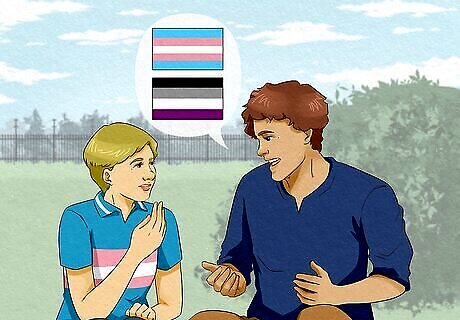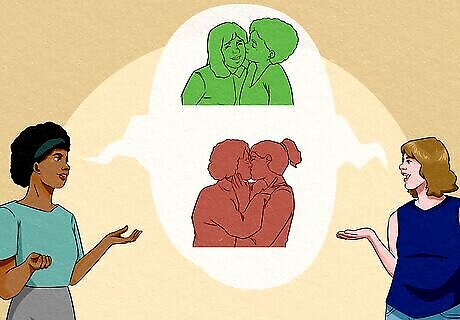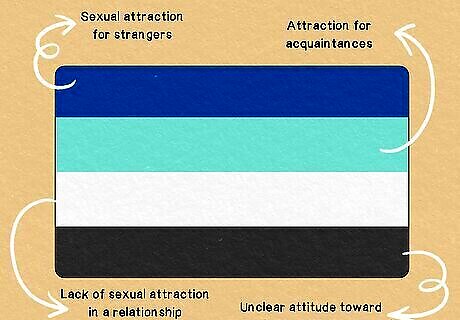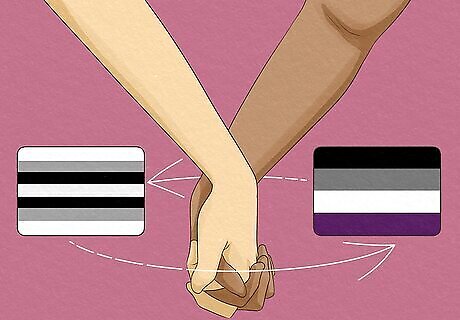
views
- You might identify as fraysexual if you tend to develop an attraction for strangers rather than friends.
- Fraysexual individuals can experience sexual and romantic attraction to people of any gender identity. A fraysexual person could identify as gay, lesbian, bisexual, etc.
- Fraysexuality is the opposite of demisexuality, or a sexual orientation where people only feel sexual attraction to people they have a close emotional bond with.
What is fraysexuality?

A fraysexual is more sexually attracted to people they don't know well. In the LGBTQ+ vernacular, asexuality is a spectrum that encompasses all types of identities that feel little or no sexual attraction (or they only experience sexual attraction under certain conditions). Fraysexuality, in particular, refers to people who prefer to be sexually intimate with strangers or people they don’t know very well, rather than people they share a close bond with. The aromantic counterpart of fraysexual is known as “frayromantic.” This refers to individuals who experience stronger romantic attraction to individuals they don’t very well. As they get to know someone better, this romantic attraction starts to fade.

Fraysexuals can identify as straight, lesbian, bi, or any other orientation. Fraysexuality speaks to the closeness of a relationship rather than the gender identity of a person’s partner. With this in mind, a person can identify as fraysexual while also identifying as straight, lesbian, bisexual, pansexual, or any other label that feels right to them. Basically, there’s no requirement for who can/can’t identify as fraysexual—if you feel like the label and definition apply to you, you’re more than welcome to use it!
Signs You Might Be Fraysexual

Your sexual attraction in your relationships decays over time. A key component of being fraysexual is noticing a dip in your sexual attraction as you spend more time with someone. If you’ve consistently found that your sexual attraction has declined in past crushes or relationships, you might be fraysexual.

You really enjoy the “newness” of a relationship. Fraysexuality hinges on how long you’ve known someone, with the strongest elements of sexual attraction occurring at the beginning of the relationship. If you consistently find yourself basking in a feeling of happiness and magnified attraction toward the beginning of your relationship that starts fading away, you could be fraysexual. It’s important to note that many couples go through a honeymoon phase, or a portion of time early on in a relationship where both parties feel especially enamored and in love with one another. If your feelings of attraction start to fade after some time, you and your partner might just be leaving the honeymoon phase of your relationship.

You desire romantic structure in your relationships. Fraysexuality is a sexual orientation, meaning that it speaks to a person’s sexual attraction—not their romantic attraction. Even if your sexual attraction starts to fade away, you still may desire a consistent level of romance and romantic structure in your relationship. Keep in mind, though, that a myriad of factors can lead to a lack of intimacy in a relationship including communication issues, a lack of trust, work-life imbalance, and more. If something like this is a major stressor in your relationship, it could be the cause of your fading sexual attraction (rather than your sexuality).
How Fraysexual Relationships Work

Communicate with your partner about what you need. Naturally, communication is an important element of any healthy relationship—but it’s especially important when you identify on the asexual spectrum. Let your partner know what your sexual preferences are, and listen to theirs in return. When you both communicate with one another, it’ll be a lot easier to strike a healthy balance in your relationship.

Redefine the boundaries of your relationship. As a fraysexual, it might be easier to get your sexual needs met by strangers and acquaintances rather than your partner—and that’s okay, as long as you and your partner communicate about it. For instance, you might try opening up your relationship, so you can get your sexual needs met while still maintaining your original relationship. You might also identify with relationship paradigms like: Queerplatonic relationships: Queerplatonic relationships are more like a tight friendship rather than a romantic or sexual relationship. They can function identically to other types of relationships, with both partners living together or even starting a family. Polyamorous relationships: Polyamory involves being in a consensual relationship with more than one individual at a time. These relationships can be in a variety of different structures, depending on the needs of you and your partners. No relationship: You might be content to have a fleeting sense of attraction for someone once in a while without ever acting on it. That’s totally valid! At the end of the day, deciding to pursue a relationship is an entirely personal decision that depends on your own sense of personal fulfillment.

Be clear on what qualifies as “sexual” or not. As your partner learns more about your sexual orientation, they might be a bit confused about what types of gestures are considered romantic versus sexual (like kissing). Make it really clear about what you are and aren’t comfortable with, so your partner doesn’t accidentally violate your boundaries. For instance, you might explain that you like gentle kisses (like a kiss on the lips after a day at work) but you’re less comfortable with making out or French kissing.

Practice active listening within your relationship. Active listening is all about giving your partner your full attention—this means getting rid of any potential distractions, like your phone. As your partner shares what’s on their mind, make an effort to maintain eye contact, nod periodically, and ask follow-up questions. If you and your partner ever aren’t on the same page (especially when it comes to a discrepancy in sexual preferences), active listening skills can help you respectfully find common ground.

Let your existing partner know if you identify as fraysexual. If you’ve recently discovered that you’re fraysexual, it’s best to keep your existing partner in the loop for the sake of transparency in your relationship. Explain what this means for the future of your relationship, and set any clear boundaries that your partner needs to keep in mind moving forward. You might explain re-negotiate how often you have sex, and/or if it would be better to open the relationship to better meet both of your sexual preferences.
Fraysexual Flag

The fraysexual flag features 4 horizontal stripes. The first stripe is blue, and signifies a sense of sexual attraction for strangers, while the second, cyan stripe symbolizes attraction for acquaintances. The third, white stripe represents a lack of sexual attraction in a relationship, and the fourth, gray stripe symbolizes an unclear attitude toward sexual attraction in general.
Other Asexual Labels & Identities

Demisexual Demisexuality is a sexual orientation where people only feel sexual attraction after they’ve already established a close emotional bond with the person beforehand. Think of it as the polar opposite of fraysexuality.

Gray-asexual Gray-asexuality refers to someone who doesn’t quite identify with black-and-white terms like “asexual” (not feeling sexual attraction toward others) and “allosexual” (which describes feeling sexual attraction toward others). Instead, they fall into a “gray” area of asexuality—this might involve feeling sexual attraction sometimes, or only under certain conditions. It ultimately depends on the person!

Aceflux The term aceflux refers to someone whose sense of sexual attraction shifts around on the asexual spectrum. They might shift between asexual and allosexual, or shift between different variations of asexuality.

Reciprosexual Reciprosexuality revolves around only experiencing sexual attraction to people who have expressed attraction to you first. It’s the opposite of lithosexual, or the ability to develop feelings of sexual attraction but not wanting said feelings returned or reciprocated.

Cupiosexual Cupiosexual people don’t experience sexual attraction as allosexual individuals do, but still desire to be in a sexually active relationship.




















Comments
0 comment